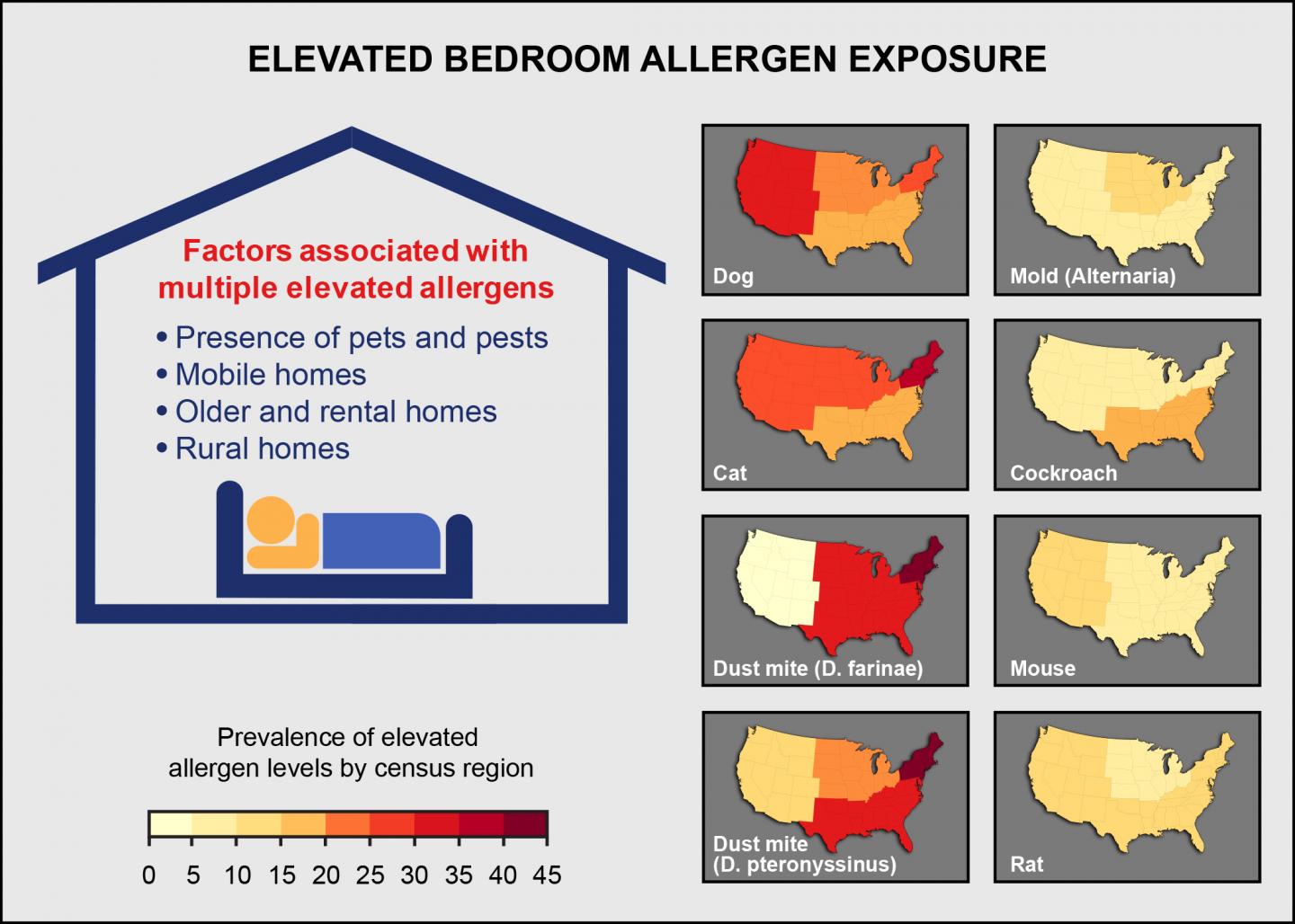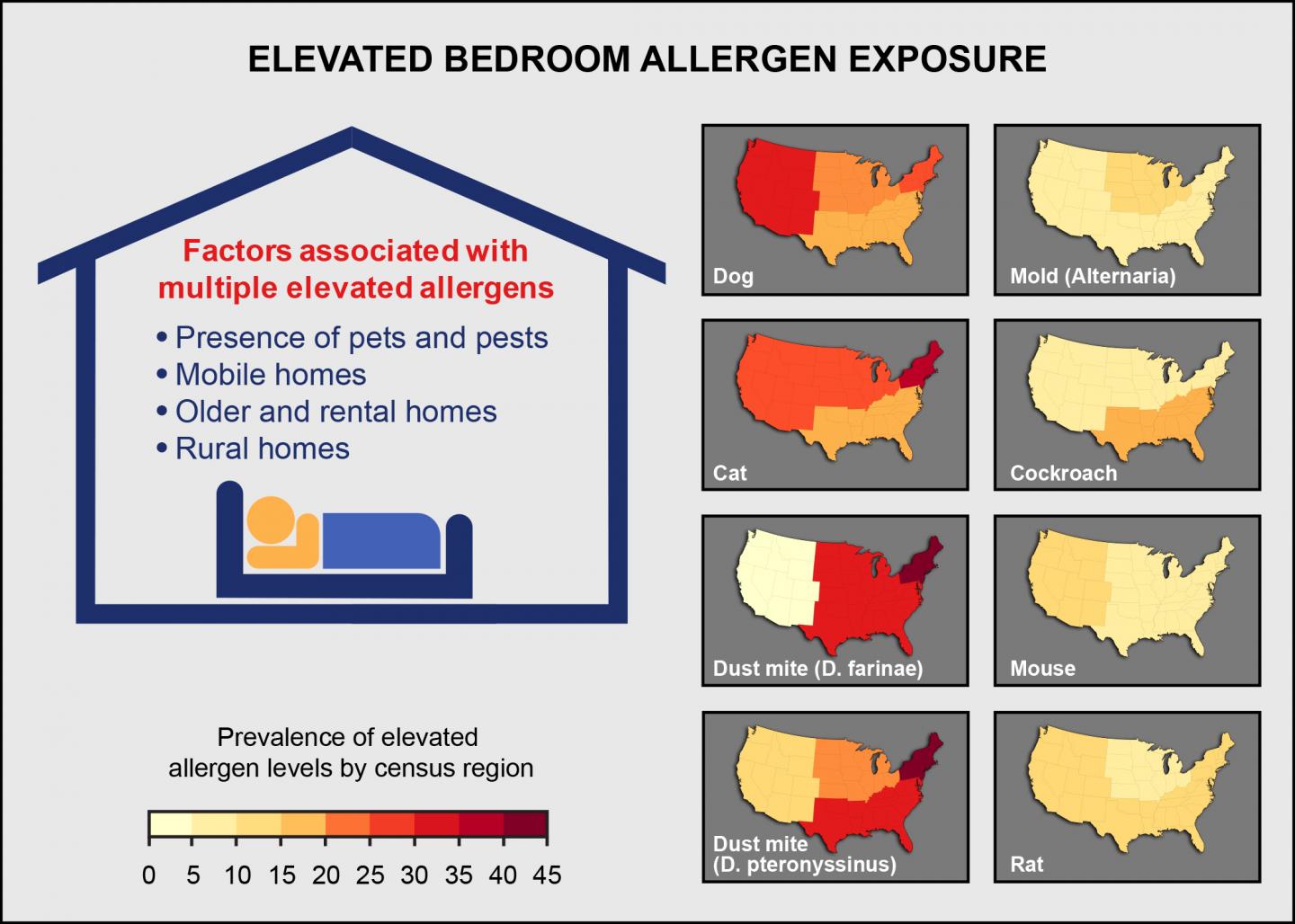
Credit: NIEHS
Allergens are widespread, but highly variable in U.S. homes, according to the nation's largest indoor allergen study to date. Researchers from the National Institutes of Health report that over 90 percent of homes had three or more detectable allergens, and 73 percent of homes had at least one allergen at elevated levels. The findings were published November 30 in the Journal of Allergy and Clinical Immunology.
"Elevated allergen levels can exacerbate symptoms in people who suffer from asthma and allergies, so it is crucial to understand the factors that contribute," said Darryl Zeldin, M.D., senior author and scientific director at the National Institute of Environmental Health Sciences (NIEHS), which is part of NIH.
Using data from the 2005-2006 National Health and Nutrition Examination Survey (NHANES), the researchers studied levels of eight common allergens – cat, dog, cockroach, mouse, rat, mold, and two types of dust mite allergens – in the bedrooms of nearly 7,000 U.S. homes.
They found that the presence of pets and pests had a major influence on high levels of indoor allergens. Housing characteristics also mattered – elevated exposure to multiple allergens was more likely in mobile homes, older homes, rental homes, and homes in rural areas.
For individual allergens, exposure levels varied greatly with age, sex, race, ethnicity, and socioeconomic status. Differences were also found between geographic locations and climatic conditions. For example, elevated dust mite allergen levels were more common in the South and Northeast, and in regions with a humid climate. Levels of cat and dust mite allergens were also found to be higher in rural areas than in urban settings.
To provide a more complete picture, the research team also compared allergen exposure and previously reported sensitization patterns from this survey. Sensitization, which makes a person's immune system overreactive to allergens, may increase the risk of developing allergies and asthma. NHANES 2005-2006 allowed national level comparisons of exposure and sensitization for the first time.
The team uncovered several differences. Although males and non-Hispanic blacks were less likely to be exposed to multiple allergens, sensitization was more common in these groups, compared to females and other racial groups, respectively. Patterns also differed for urban and rural settings. Exposure to several elevated allergens was most prevalent in rural areas, whereas sensitization rates were shown to be higher in urbanized areas.
Overlaps were also found. For dust mite allergens, exposure and sensitization was most prevalent in the Southern and Northeastern regions, and for cockroach allergen in the South. Patterns also reflected socioeconomic variations, especially for pet and cockroach allergens, according to lead author Paivi Salo, Ph.D., of NIEHS.
The researchers emphasized that the relationships between allergen exposures, allergic sensitization, and disease are complex. Studies are still investigating how allergen exposures interact with other environmental and genetic factors that contribute to asthma and allergies.
In the meantime, the following preventive actions may help reduce exposure to indoor allergens and irritants.
- Vacuuming carpets and upholstered furniture every week.
- Washing sheets and blankets in hot water every week.
- Encasing mattresses, pillows, and box springs in allergen-impermeable covers.
- Lowering indoor humidity levels below 50 percent.
- Removing pets from homes or at least limiting their access to bedrooms.
- Sealing entry points and eliminating nesting places for pests, as well as removing their food and water sources.
"Asthma and allergies affect millions of Americans," said Salo. "We hope this comprehensive study provides beneficial information to a wide audience, from patients to clinicians."
###
Grant numbers:
Z01ES025041
UM2AI117870
P30ES005605
Reference: Salo P, Wilkerson J, Rose KM, Cohn RD, Calatroni A, Mitchell HE, Sever ML, Gergen PJ, Thorne PS, Zeldin DC. 2017. Bedroom allergen exposures in US households. J Allergy Clin Immunol; doi: 10.1016/j.jaci.2017.08.033 [Online 30 November 2017].
NIEHS supports research to understand the effects of the environment on human health and is part of NIH. For more information on environmental health topics, visit http://www.niehs.nih.gov. Subscribe to one or more of the NIEHS news lists to stay current on NIEHS news, press releases, grant opportunities, training, events, and publications.
About the National Institutes of Health (NIH): NIH, the nation's medical research agency, includes 27 Institutes and Centers and is a component of the U.S. Department of Health and Human Services. NIH is the primary federal agency conducting and supporting basic, clinical, and translational medical research, and is investigating the causes, treatments, and cures for both common and rare diseases. For more information about NIH and its programs, visit http://www.nih.gov.
NIH…Turning Discovery Into Health®
Media Contact
Virginia Guidry
[email protected]
919-541-1993
@niehs
http://www.niehs.nih.gov
Original Source
https://www.niehs.nih.gov/news/newsroom/releases/2017/november30/index.cfm http://dx.doi.org/10.1016/j.jaci.2017.08.033





